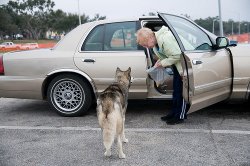What to do if You Find a Lost Pet
July 14, 2009 by LaBecs
Filed under To Rescue or Not: What to do if You Find a Lost Pet
What do you do if you are driving and all of a sudden you see a dog or a cat roaming alone on the street? If you’re an animal lover, I know this is a heart wrenching situation. Do you rescue it or not? If you decide against it… at least call animal control and give the details of where you saw the animal. You will at least be giving it a small chance of getting rescued.
But, put yourself in the original owners place and think what you would want the finder of your animal to do if he found him hurt or without his collar.
 If you’ve never lost a beloved animal you might think that the owner of the found dog or cat abandoned him or neglected to keep him safely confined. But accidents can happen. The frantic owner could be looking everywhere for their pet.
If you’ve never lost a beloved animal you might think that the owner of the found dog or cat abandoned him or neglected to keep him safely confined. But accidents can happen. The frantic owner could be looking everywhere for their pet.
If you decide to rescue it:
Stop for a bit and observe the animal. Does he have a collar? Is he acting scared? Does it look hurt? If you decide that it’s lost, be careful. Not all dogs and cats are friendly, and a hurt animal can be aggressive. Open the back door of your car slowly, as not to startle him or her and call it over… if it comes on its own, great. Don’t try to force it or approach him too fast. Speak softly and try to reassure him. If you’re not able to restrain the animal in a safe way, call the local police or animal control agency.
If you are able to capture him, check for a collar or an ID chip. If you are lucky, he’ll have one and you can call immediately. Otherwise, your first stop should be an animal hospital. They can check for a microchip and find the owners if they find one. If you are planning on taking him or her home, ask the animal hospital to give you flee treatment that you can give right away. If it’s hurt, be ready to take the financial responsibility of his care. If you’ve already made up your mind to take him home, a full vet’s checkup is a good idea, but you have to be willing to pay for it.
That’s the toughest decision: will you take it home or will you take it to the humane society or a shelter? Unfortunately, most animal agencies don’t have the budget to sustain many animals at a time, and most of them euthanize strays in a few days. If you take the animal there, ask for a case number and make sure you leave your information. Make sure to call everyday and see if the owners came forward, otherwise, be ready to take him out before they euthanize him. You can tell them you are taking him home, but it’s important that they know you have the animal, since that is the first place the owners are going to look.
Taking him home will give you a whole new set of responsibilities. You will have to bathe and feed him or her. Be careful with you other animals. You don’t know if this found animal has had all its shots and might put your own pets at risk, so try to keep it separated until you get it checked. Sometimes you can tell by the appearance of the animal if he was lost recently and how well it was taken care off. Is it groomed? Clean? Are his teeth clean? Use your judgment. But remember that if it’s been lost for many days, it won’t look very pretty, so don’t assume it was mistreated or abandoned. The most beloved pets sometimes get out and get lost.
Now it’s time to take pictures. Colored posters work best. Don’t give out every detail of the animal, so you can weed out the real owners. Say it has a collar, but don’t say what color, etc. Post the signs around the area where you found it and a little beyond. Take the poster to different shelters in the area, vet offices, grooming facilities, etc. Use Craigslist! You can post the picture for free. There are many Lost Pet websites where you can register the animal. Call the newspaper. Posting a lost pet announcement is not that expensive. Do you best to find the owners. It can take some time.
Think about what to do while you look for the owners
Can you keep it in your home? Are you willing to return him to his original home if the owner turns up after a while? Can you find him a temporary home until you find the owners? How about a permanent home if you are not lucky in your search?
Check with the ASPCA, the Humane Society and other animal agencies in you area to find out the guidelines about lost and found pets. They can give you more ideas. But all in all, if the animal stays with you while you find its owners, they stand a better chance of surviving. It might be a little costly to be a Good Samaritan, but there are many clinics and agencies that might be willing to help. After all, isn’t it worthwhile to save a life?
What do you do if you are driving and all of a sudden you see a dog or a cat roaming alone on the street? If you’re an animal lover, I know this is a heart wrenching situation. Do you rescue it or not? If you decide against it… at least call animal control and give the details of where you saw the animal. You will at least be giving it a small chance of getting rescued.
But, put yourself in the original owners place and think what you would want the finder of your animal to do if he found him hurt or without his collar.
If you’ve never lost a beloved animal you might think that the owner of the found dog or cat abandoned him or neglected to keep him safely confined. But accidents can happen. The frantic owner could be looking everywhere for their pet.
If you decide to rescue it:
Stop for a bit and observe the animal. Does he have a collar? Is he acting scared? Does it look hurt? If you decide that it’s lost, be careful. Not all dogs and cats are friendly, and a hurt animal can be aggressive. Open the back door of your car slowly, as not to startle him or her and call it over… if it comes on its own, great. Don’t try to force it or approach him too fast. Speak softly and try to reassure him. If you’re not able to restrain the animal in a safe way, call the local police or animal control agency.
If you are able to capture him, check for a collar or an ID chip. If you are lucky, he’ll have one and you can call immediately. Otherwise, your first stop should be an animal hospital. They can check for a microchip and find the owners if they find one. If you are planning on taking him or her home, ask the animal hospital to give you flee treatment that you can give right away. If it’s hurt, be ready to take the financial responsibility of his care. If you’ve already made up your mind to take him home, a full vet’s checkup is a good idea, but you have to be willing to pay for it.
That’s the toughest a decision: will you take it home or will you take it to the humane society or a shelter? Unfortunately, most animal agencies don’t have the budget to sustain many animals at a time, and most of them euthanize strays in a few days. If you take the animal there, ask for a case number and make sure you leave your information. Make sure to call everyday and see if the owners came forward, otherwise, be ready to take him out before they euthanize him. You can tell them you are taking him home, but it’s important that they know you have the animal, since that is the first place the owners are going to look.
Taking him home will give you a whole new set of responsibilities. You will have to bathe and feed him or her. Be careful with you other animals. You don’t know if this found animal has had all its shots and might put your own pets at risk, so try to keep it separated until you get it checked. Sometimes you can tell by the appearance of the animal if he was lost recently and how well it was taken care off. Is it groomed? Clean? Are his teeth clean? Use your judgment. But remember that if it’s been lost for many days, it won’t look very pretty, so don’t assume it was mistreated or abandoned. The most beloved pets sometimes get out and get lost.
Now it’s time to take pictures. Colored posters work best. Don’t give out every detail of the animal, so you can weed out the real owners. Say it has a collar, but don’t say what color, etc. Post the signs around the area where you found it and a little beyond. Take the poster to different shelters in the area, vet offices, grooming facilities, etc. Use Craigslist! You can post the picture for free. There are many Lost Pet websites where you can register the animal. Call the newspaper. Posting a lost pet announcement is not that expensive. Do you best to find the owners. It can take some time.
Think about what to do while you look for the owners
Can you keep it in your home? Are you willing to return him to his original home if the owner turns up after a while? Can you find him a temporary home until you find the owners? How about a permanent home if you are not lucky in your search?
Check with the ASPCA, the Humane Society and other animal agencies in you area to find out the guidelines about lost and found pets. They can give you more ideas. But all in all, if the animal stays with you while you find its owners, they stand a better chance of surviving. It might be a little costly to be a Good Samaritan, but there are many clinics and agencies that might be willing to help. After all, isn’t it worthwhile to save a life?
Photo Courtesy of:
The Awful Reality of Puppy Mills
June 1, 2009 by LaBecs
Filed under The Awful Reality of Puppy Mills
You’ve probably heard about puppy mills. But did you know that if you purchase a dog from a pet store and many of the breeders online or in the newspaper, you could be helping keep the puppy mill industry afloat?
Most people don’t realize where those dogs who suffer so much end up. They often don’t even know how much suffering the dogs have to endure. Below is some information you should read before you decide how to find your new canine companion.
The Abuses of Puppy Mills
If you’re not familiar with the term “puppy mill”, you may want to learn about them before you start looking around for your new puppy or dog. Basically, puppy mills operate like factories to produce new offspring that can be sold.
Female dogs are bred from their first heat cycle and again each time until they are no long able to reproduce. Then they are “disposed of.” The puppies are kept with their mothers in tiny cages, usually stacked on top of one another in cramped and dirty environments. Because the cages are made from wire, the excrement and urine from the above dogs can fall down onto the lower dogs. The wire cages also cause foot injuries and are very uncomfortable.

A Living Hell
Most of the dogs are underfed. Most have worms because of their close quarters and their unhygienic environment. Fleas and mites are huge problems because most of these puppy mills are located in the country and none of them receive any type of preventative care. Some even contract heart worms and other serious illnesses. They also tend to have emotional problems because they lack any human contact during their formative years, and because their mothers are usually too weak to give them much compassion.
In some of the worst of these places, dead dogs are left in the cages to decompose with the living ones.
Where the Puppies Go
As you can imagine, most “hell operators”, as I like to call them, do not sell their “stock” from their factory. Instead, they have other ways of connecting with potential customers. Pet shops are one of the largest buyers. Most of the dogs you see being sold in pet stores for hundreds of dollars were bought for a fraction of that from puppy mills. However, since the puppy mills sell hundreds of dogs every couple of months, they are profiting from these sales in major ways.
But pet stores are only one method. Many of the breeders who advertise online and in the newspaper are also puppy mills themselves or are selling supplies of dogs they have gotten from puppy mills.
What you get is a puppy facing an array of immediate medical problems and with genetic diseases that will surface years later.
Signs of a Puppy Mill
Regardless of what pet stores may say, their supply of dogs comes from puppy mills. However, with breeders, you may have a harder time recognizing the possibilities. To protect yourself, always ask to visit the puppies on-site so you can view the condition of the mother and possibly the father. For obvious reasons, if you are buying directly from a puppy mill, they will have some excuse as to why you cannot do this.
If you do arrive on-site but are not allowed to see the mother of the puppies, this is also a sign the puppies may be from a puppy mill and that the mother may be another location altogether.
Never buy a puppy without seeing where they and their parents are raised and housed with your own eyes. Do your research; get references about breeders in your area.
While your heart may go out to these suffering puppies, when you buy them from these sources you’re only contributing to the problem and continuing the puppy mill business. That’s why I always urge and encourage people to adopt either from a humane society, a rescue, or a shelter, and help put those torture chambers out of business for good.
How to Choose the Right Dog
March 24, 2009 by LaBecs
Filed under How to Choose the Right Dog
You might think that deciding whether to adopt a dog or not is the toughest part. However, wait till you get to the shelter! With so many little adorable four-legged fur-balls and puppy-eyes around, you just won’t know which one to take home! They come in so many shapes and sizes and each of them has one adorability factor or another and it can just get to be too much. You have to understand that if you don’t know how to choose the right dog there will be problems down the line.
It would be really unfair, incorrect actually, to say that one breed is better than other, especially in a shelter, where any one of the dogs could be a treasure. What is actually of essence is to see which dog would be better for your specific situation, needs and limitations. Therefore, the following points might help:
1. Understand your limitations
Understanding your constraints as an owner is the first step. This is more important than deciding which dog looks cutest. Let’s say you live in condo or an apartment, in which case you would want a dog that is small and can do without much daily exercise. If you have a large house with a backyard, then almost any breed will work fine. Think about your time commitments, the other members of the household, even your social life will decide which personality, breed and size will work for you.
2. Learn about different breeds

Chuck and Terry
The breed of the dog considerably influences his or her personality, behavioral traits and physiology – and you need one that matches your considerations. Essentially there are two basic classifications: pure breeds and mixed breeds. Purebred dogs come from a family of same breeds and thus it is easier to know for sure what traits he will display and what his health might be like. With a mixed breed, the parental lineage could include just about any dog. These breeds tend to be genetically more sound, and often show very good health when cared for well. Also, you get the qualities of various dogs in one. Of course some people prefer pure breeds for the certain snob value they hold, but after all, it’s all about who wins your heart.
3. Visit the shelter
Once you have some idea about the different breeds, a visit to the shelter will prove beneficial. Now, a shelter is not exactly the best place for a dog and most of the time the dog will not be himself. Therefore first impressions could be wrong. It is good to have an adoption counselor by your side as you walk through or a volunteer who might be able to give you a better insight into the dog’s personality and help you make a decision. Insist on spending sometime alone with a few dogs that you might like and consider the following:
Age: A younger puppy is usually desired since it is easier to habituate a pup to your home and lifestyle. However, puppies also require some training – especially toilet training and general obedience training. Older dogs, on the other hand, are already trained by their owners which would be saving you some effort. However, they might also posses certain habits that don’t go down well with you and it’s hard to change that with older dogs. Decide depending on your lifestyle.
Size: Think if you want to be able to take your pet along often, in which case you need a smaller kind. However, if you have young kids, the smaller dogs are not the most appropriate. Again, check your breed characteristics.
Personality: Dogs are usually shy and quiet or assertive and active. If you like some peace and quiet, then a terrier who barks his head off at any new thing may not be for you. But if you like jogging, running around parks or have active kids, then an active retriever will suit you just fine
Social disposition: Depending on their past experiences with people, certain dogs are very picky about social interaction. They will just not let anyone but their owner touch them and could turn quite hostile if someone intrudes on their privacy. Therefore, try to find out a little about the dog’s background to avoid any unpleasant surprises. Most dogs however, tend to be social and very friendly. Take a look at the dog’s history and discuss his general behavior with the counselor or volunteers and you will have an idea how good he is with people.
Usually, if a dog’s previous owners were unkind to him, or even violent, the dog might be untrusting of all people. Although such dogs deserve love and care as well, it’s up to you to decide if you are in a situation to provide it with the patience that it requires.
A dog will be your best friend for life!
A dog suited to your personality and lifestyle can bring you great joy and fun, and a wrong decision might bring you some inconveniences that shadow on the happy parts. Although all dogs can be your best friends, this is going to be more like a live-in relationship; so you need to be very sure of your compatibility. Trust me, breaking up with your dog can be very painful.
Are You Really Ready to Adopt a Pet?
March 24, 2009 by LaBecs
Filed under Are You Really Ready to Adopt a Pet?
It always happens. Every time you see the picture of a cute little pup or furry little kitten, you ‘awww’ and ‘oooh’ and you just want one! You can’t help but pet each dog that comes your way while walking on the street and you bring tasty treats for your friend’s pets when you go visiting.
Every time a pup licks you or a cat rubs against your leg, you think it’s a sign telling you to get your own. But hold your horses! (or doggies, or kitties, as you might prefer). Adopting a pet is about a lot more than signs or gut feelings or even desires.
We’re not discounting desire as a factor in bringing home a pet – it is important – but there are other factors that are much more important. Many owners have fallen prey to the misconception that the ‘I-just-saw-him-and-fell-head-over-heels-in-love’ feeling will see them through the 15 odd years they will spend with their pets. Adopting a pet is quite a happy thought. However, it needs to be turned into reality. You need to give owning a pet a lot of thought.
The following points make it easier for you to judge if your decision is really sound, read it through and answer each point honestly to reach a conclusion.
What’s your reason for adopting?
Adopt for a reason that will last, since that will determine how healthy and enjoyable your relationship will be. Reasons like momentary loneliness, boredom, or curiosity might not be ideal, since these conditions will pass. You need a reason that will keep for many, many years to come.
Do you have time?
Having a pet in your house requires a good investment of time, and it can’t be put on a schedule of maybe one hour a day. When your pup is young, you will have to spend a lot of time with him, training him and getting him used to your home. When he falls sick, you’ll have to be by his side. And, you should give them this time gladly, not just out of obligation.
 Can you afford it?
Can you afford it?
Adopting doesn’t just involve the cost of adoption fees. Taking care of a pet comes along with a series of expenses – good food, grooming, hygiene, toys, changes to your house, regular vet visits, medication, and what not.
What is you lifestyle?
Do you live in a place where you can share space comfortably with a pet? If you live in a condo you might feel cramped and your neighbors or landlord might object. Also, if you work late nights, have a baby, travel a lot or have an erratic schedule, a pet might not fit well into your scheme of things.
What happens if something goes wrong?
 What if you get sick or you have to leave the pet alone? Do you have someone you can count on to help you out? Becoming solely responsible for another life is a big decision. You will need some kind of help (friends, relatives, friendly neighbors) or at least the financial means to hire such help.
What if you get sick or you have to leave the pet alone? Do you have someone you can count on to help you out? Becoming solely responsible for another life is a big decision. You will need some kind of help (friends, relatives, friendly neighbors) or at least the financial means to hire such help.
Will you commit?
The most important question: Do you think you can love, cherish and take care of your pet for as long as he lives? I repeat – as long as he lives. This is quite a responsibility. If you’re going to adopt a pet, you will need to promise yourself that you will take care of him to the best of your ability. And taking care of a pet is quite a task.
If most of these questions make you reconsider your decision, don’t lose heart. It’s all for the best. Visit any animal shelter and you will notice that most of the animals are there because their owners didn’t think of all these questions, got carried away by their feelings and took the animal home, only to realize a year later that they couldn’t handle it. It is a highly insensitive act – to willingly welcome someone into your home and then turn them out – especially someone as helpless and innocent as a poor little dog or cat.
All these factors are just as important if not more as what ‘kind’ of a pet you want to have. For instance, dogs require exercise, some, at least an hour every day. If you live in an apartment in the city and you don’t like to walk, this becomes unfeasible. Even a tiny and active little terrier is more suited with owners who have the time to give it exercise and play with it. But don’t think a cat is any easier… well it is, since you don’t have to walk them, but they do need play time, and attention, and although they have this reputation of being independent, they crave company and they need it to be healthy and happy.
Welcoming a pet into your house and your life can be one of the most enriching experiences you ever have. However, thinking it through is very important. When you bring a pet home, it’s just as having a baby – every decision you make thereon affects you and your pet in equal measure. It’s a living being who you will share a good part of your life with… but oh, what a fulfilling life it will be.
Bringing a New Puppy Home
March 24, 2009 by LaBecs
Filed under Life With Dogs
You got your new puppy almost a week ago. Since then, the little angel has eaten your favorite shoes, two of your favorite novels, gnawed the trim around every doorway, chewed through the power cord of your computer and this morning he found boxes and boxes of kleenex in your bathroom… what a mess! This is getting really expensive and it’s starting to get very dangerous for the puppy also. Maybe you should do something.
What do you do?
You need to understand that chewing is a normal and healthy part of any pup’s development, but they should know what to chew, right? Puppies are like human children, they learn about their world through chewing. They use their senses to explore the new world, and their tactile sense and sense of taste is brought into play as they chew on various objects.
Like human children, pups need our protection from the dangers of the dangers that lurk in their explorations.
Everything from needles, electrical cords, houseplants and household chemicals, to chocolate and raisins, all pose very real threats to your pet. It is your duty to protect her from these threats.
You have to be very consistent training him with the “NO” command. You puppy should learn and respond to the word “No” instantly. This one word has saved many dogs from horrible fates. The puppy is trained by using the “NO” command every time a situation occurs. If you catch your pet chewing on your shoes, say “NO” in a serious tone, not screaming, not angry, and take the item from him or her. Don’t let it become a tug-o-war. Just remove the item quickly and give him a suitable toy. Also, try not to chase him when he has the object in his mouth or he’ll think it’s a game.

Lady Pee
When I bring a puppy home, I like to use one of my unwashed pillow cases, and put a lot of different toys with different textures (hard plastic, cloth, soft plastic, rubber, etc.) in it. Then I choose one toy of each textures, and those are his toys for the day. That way he doesn’t get bored, and since the toys have my scent, it helps the bonding process as well.
Another thing I do is buy marrow bones and boil them just a few minutes just enough to get the marrow out. Then I wrap them in foil and freeze them. This serves two purposes: one, it keeps him entertained and happy for hours, specially if I give it to him just before I leave. And two, the frozen bone alleviates the pain of his growing teeth, so he’ll be grateful. Just be careful never to boil the bones more than 4 or 5 minutes, and never give him any other kind of bone! You can give him raw-hide bones, but not too many, just once in a while. Pieces of ice are also a good idea. My dogs have always loved to chew on those!
With these simple suggestions, you can insure your puppy’s good health and the well being of many, many shoes.
Adopting from an Animal Shelter
March 13, 2009 by LaBecs
Filed under Adopting From an Animal Shelter
Animal shelters from your local Humane Society are your best source when looking for a cat or a dog to bring into your family. Not only do they have a great selection of adult animals for adoption, but they also have kittens and puppies, even purebred animals. On average, purebreds account for about 25 to 30 percent of a shelter’s dog population. So before you look for a dog or a cat for sale, go to the American Humane Society, and take the steps to adopt a dog, or a cat that really needs a home.
Many pets at your local shelter are waiting for new homes because they were obtained by someone with unrealistic expectations of the time, effort, and money required to sustain a lifelong relationship with their pet. National figures indicate that about half of the animals in shelters must be euthanized for lack of homes. Animals at your local shelter are eager to find a new home and are just waiting for someone like you.
You can depend on responsible shelters to assess the animals’ health and temperament in order to make the best adoption matches possible. When animals are relinquished by owners, the shelter staff makes every attempt to collect a thorough history of that pet. Then, while caring for animals, staff and volunteers try to learn as much as they can about these animals as well as those who come to the shelter as strays.
Don’t be discouraged if, when you first visit the shelter, there are no animals of the breed or type you want. Shelters receive new animals every day.
 Your shelter may also have a waiting list and can call you when an animal matching your preference becomes
Your shelter may also have a waiting list and can call you when an animal matching your preference becomes  available. Before choosing your pet, you can even speak with an adoption counselor about whether your choice of a particular type or breed will be best for you. In an effort to make good matches between people and animals and to place pets in lifelong homes, many shelters provide adoption counseling and follow-up assistance, such as pet parenting and dog-training classes, medical services, and behavior counseling. Or they may be able to refer you to providers of these services.
available. Before choosing your pet, you can even speak with an adoption counselor about whether your choice of a particular type or breed will be best for you. In an effort to make good matches between people and animals and to place pets in lifelong homes, many shelters provide adoption counseling and follow-up assistance, such as pet parenting and dog-training classes, medical services, and behavior counseling. Or they may be able to refer you to providers of these services.
Another advantage is that shelter adoption fees are usually much less than an animal’s purchase price at a pet store or breeder. And your new pet is more likely to be vaccinated, dewormed, and spayed or neutered.
To locate your local animal shelter, check the Yellow Pages under “animal shelter,” “animal control,” or “humane society.” Many shelters have websites on which they display the animals they have available for adoption. Some sites allow you to download adoption forms and read about responsible pet care. |
A growing number of shelters also promote their web sites, and the animals they have for adoption, on sites such as Pets 911, Petfinder, and 1-800-Save-A-Pet.com.
Reprinted by permission of The Humane Society of the United States



